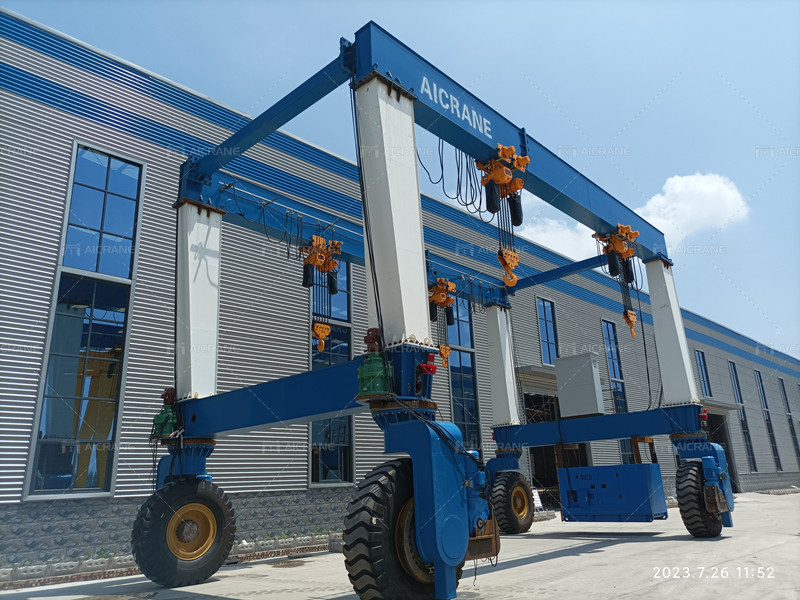Rubber Tyred Gantry (RTG) cranes are indispensable in ports and container terminals, providing the mobility needed to handle containers efficiently. The tires of a rubber tyred gantry crane play a crucial role in its operation, and their maintenance or replacement is vital for the safe and effective functioning of the crane. This guide will detail the steps and considerations involved in fixing or replacing the tires of a rubber tyred gantry crane, ensuring minimal downtime and maximum operational efficiency.

Introduction to Rubber Tyred Gantry Cranes
Rubber tyred gantry cranes are large mobile cranes that use rubber tires instead of tracks, allowing them to move freely within container yards. These cranes are primarily used to stack containers, load and unload trucks, and organize containers in the yard. The tires must support the heavy loads and constant movements, making their condition critical to the crane’s performance and safety.
Importance of Tire Maintenance
Regular maintenance of rubber tyred gantry crane tires is essential to prevent unexpected failures that can lead to costly downtimes and potential safety hazards. Proper maintenance extends the lifespan of the tires and ensures that the crane operates smoothly. Worn-out or damaged tires can cause instability, increase the risk of accidents, and reduce the crane’s efficiency.
Signs of Tire Wear and Damage
Before delving into the repair or replacement process, it is important to recognize the signs that indicate the need for tire maintenance:
Visible Tread Wear: Excessive tread wear can reduce traction and increase the risk of slippage.
Cracks and Cuts: Any visible cracks, cuts, or punctures on the tire surface indicate potential failure points.
Bulges and Blisters: These suggest internal damage to the tire structure, often due to overloading or impact damage.
Uneven Wear Patterns: Uneven wear can be caused by misalignment, improper inflation, or load imbalance, indicating the need for corrective measures.
Tools and Equipment Needed
To fix or replace the tires of a rubber tyred gantry crane, the following tools and equipment are typically required:
Heavy-Duty Jack or Crane: To lift the crane and safely remove the tire.
Impact Wrench: For loosening and tightening lug nuts.
Tire Lever and Bead Breaker: For removing and installing tires on the rims.
Torque Wrench: To ensure proper tightening of lug nuts to the specifications of gantry crane manufacturer.
Pressure Gauge and Air Compressor: To check and adjust tire pressure.
Safety Gear: Including gloves, safety glasses, and steel-toed boots.

Step-by-Step Process to Fix or Replace Tires
Preparation and Safety Measures
Secure the Area: Ensure the crane is in a safe and stable position. Clear the area of any obstacles and unauthorized personnel.
Engage Parking Brakes and Use Wheel Chocks: To prevent any movement of the crane during the tire change process.
Inspect the Crane: Conduct a thorough inspection to identify any other potential issues that may need attention during the maintenance period.
Lifting the Crane
Position the Jack or Crane: Place the heavy-duty jack or crane at the designated lifting points on the rubber tyred gantry crane. Refer to the manufacturer’s manual for proper lifting points to avoid damaging the crane structure.
Lift the Crane: Slowly lift the crane until the tire is off the ground. Ensure stability throughout the lifting process.
Removing the Damaged Tire
Loosen Lug Nuts: Using the impact wrench, loosen the lug nuts on the tire while it is still on the ground. This prevents the tire from spinning when elevated.
Remove Lug Nuts and Tire: Once the crane is lifted, completely remove the lug nuts and carefully take the tire off the hub.
Fixing or Replacing the Tire
Inspect the Rim: Before installing a new tire, inspect the rim for any damage or debris. Clean the rim thoroughly.
Fixing Minor Damages: For minor damages like punctures, use a tire repair kit to patch the holes. Ensure the patch is properly applied and sealed.
Replacing the Tire: If the tire is beyond repair, replace it with a new one. Align the new tire with the rim and use the tire lever and bead breaker to mount it correctly.
Reinstalling the Tire
Mount the Tire: Place the tire onto the hub, aligning it with the bolt holes.
Hand-Tighten Lug Nuts: Start by hand-tightening the lug nuts to ensure they are properly threaded.
Tighten Lug Nuts: Use the impact wrench to partially tighten the lug nuts. Lower the crane slightly so the tire touches the ground and can’t spin. Then, use a torque wrench to fully tighten the lug nuts to the manufacturer’s specified torque settings in a crisscross pattern to ensure even distribution of pressure.
Lowering the Crane and Final Checks
Lower the Crane: Carefully lower the crane back to the ground, ensuring it remains stable throughout the process.
Check Tire Pressure: Use a pressure gauge to check the tire pressure and adjust it with an air compressor to the recommended levels.
Inspect and Test: Perform a final inspection to ensure everything is securely in place. Test the crane by moving it slowly to ensure the tire is properly installed and functioning.
Documentation and Maintenance Log
Record the Maintenance: Document the tire replacement or repair in the crane’s maintenance log. Include details such as the date, type of maintenance performed, and any parts replaced.
Schedule Regular Inspections: Establish a routine inspection schedule to monitor tire conditions and address any issues promptly.
Fixing or replacing the tires of a rubber tyred gantry crane is a critical maintenance task that ensures the safe and efficient operation of these essential machines. By following a systematic approach to tire maintenance, including regular inspections, timely repairs, and proper replacement procedures, operators can minimize downtime, enhance safety, and prolong the lifespan of their equipment. Remember, adherence to safety protocols and manufacturer guidelines is paramount throughout the process, ensuring both the well-being of personnel and the optimal performance of the rubber tyred mobile gantry crane.